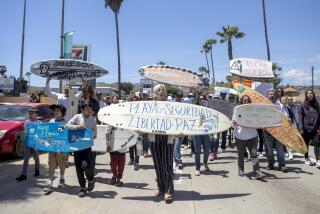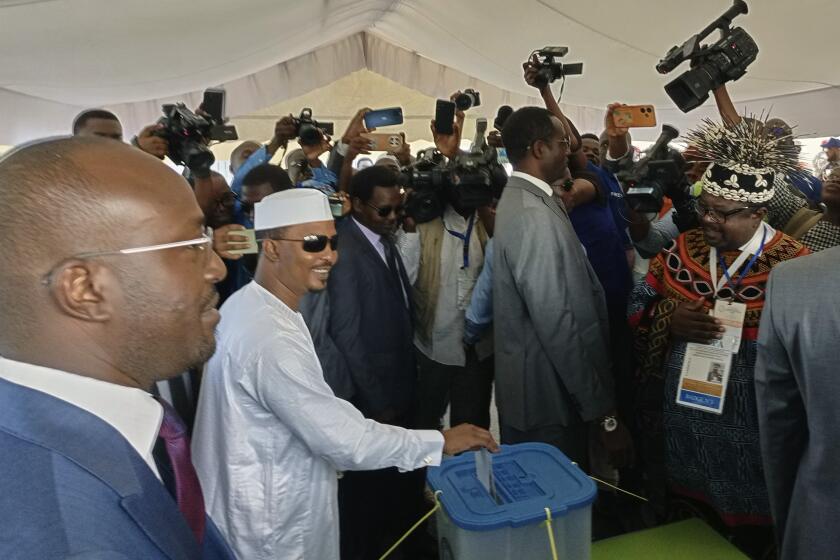China, Taiwan Groping Toward Interdependence
In 1987, Asia’s famous blood enemies, China and Taiwan, began letting their economic relations blossom.
And now, after three years of heady growth in trade, investment and other links, the two nations can point to some dramatic successes.
Taiwan and China have come to rank as each other’s fifth-largest trading partner, and Taiwan has become China’s fourth-largest investor after Hong Kong, the United States and Japan. So fruitful are their mutual economic ties that talk about the eventual formation of a Chinese common market is even starting.
Indeed, the two are finding each other to be such compatible economic partners that they are becoming interdependent--that is, each side views the other as important, if not essential, to its further economic development.
China, suffering from a slowdown in Western investment after the Tian An Men Square massacre--has found Taiwan’s technology and capital helping to make up the slack. Taiwan, adjusting to rising labor costs and tough environmental restrictions at home, has found a prosperous alternative in utilizing China’s cheap labor and manufacturing opportunities.
Such growing interdependence is finally being officially recognized. Hitherto, while cultivating trade ties, each side talked of war less and less convincingly.
Now, in a further easing of the atmosphere, Taiwan President Lee Teng-hui plans next month to lift the nation’s state of emergency and end the “Period of Mobilization for Suppression of the Communist Rebellion.”
This move follows Taiwan’s lifting of martial law in 1987 and its authorization for residents to visit family members on the mainland.
“Technically,” Lee recently advised the public, “a state of war will still exist.” But nearly everyone sees such statements as a form of charade, pretending that a more hostile state of affairs exists than is truly the case.
“The two sides have become an economic necessity for each other,” says Shelley Mark, senior research associate of the East-West Center in Honolulu and an expert on China and Taiwan. “The logic is too strong for either to resist.”
“These are dramatic changes,” said Chu-yuan Cheng, an economics professor at Ball State University. “They are drawing the two parts of China closer to each other and producing a degree of mutual dependency that may someday bond the two economies into a common market.”
These words represent profound moderation from the past. Long before the Communists chased the Nationalists off the mainland in 1949, Nationalist leader Chiang Kai-shek and Communist leader Mao Tse-tung were so obsessed with fighting each other that they never produced a genuine effort to combat the invading Japanese.
The barriers began to break down in November, 1987, when Taiwan authorized family visits to the mainland and Beijing responded by establishing policies to receive these visits. As 2 million visitors flocked to the mainland, the governments adopted more flexible attitudes toward economic and cultural exchanges, and trade and investment expanded.
Despite the bitter legacy, each side has much to offer the other. The mainland offers the cheap labor that Taiwan needs, its own work force having grown far too expensive for labor-intensive industries such as consumer electronics assembly lines. Taiwan offers capital to spare from its vast trade surpluses, and the mainland needs foreign investment to modernize.
Since 1987, 2,000 to 3,000 Taiwanese entrepreneurs have invested a total of more than $2 billion in China, setting up mostly small factories to produce such items as cheap shoes, key chains, umbrellas, underwear, plastic toys and assembly of low-scale electronic gadgetry.
Many of these items find their way back to Taiwan and into the world market.
But low-cost labor is not the mainland’s only major appeal to Taiwan investors. Taiwan’s Y. C. Wang, chairman of giant Formosa Plastics, has said he is contemplating a $7-billion petrochemical complex there to avoid the problems presented by Taiwan’s new environmental restrictions.
With Taiwan weighing even more rules regulating the environmental impact of industry, it is expected that the mainland, so far relatively indifferent to environmental concerns, may become even more attractive to Taiwan’s industrial investors.
On Taiwan’s side, the logic begins with nearness. Despite all rancor, the mainland is a close and developing market offering a shared culture and common language--”the Chinese connection,” as Mark describes it. And as Taiwan’s overseas markets tighten--including that of the United States, which suspended Taiwan’s benefits under the general system of trade preferences in January, 1989--the mainland offers lower production costs to remain competitive.
From Beijing’s view, Taiwan is not only rich--its foreign exchange reserves at $76 billion rank second in the world only after Japan’s--it also offers technology to assist in China’s modernization program as well as many products that the mainland needs.
Beijing also sees trade and investment serving a political objective as well: the softening of Taiwan attitudes toward the mainland.
During the past decade, China’s expanding economy has bought a total of about $10 billion more in goods from Taiwan than it has sold to Taiwan. Now, two-way trade runs $4 billion a year, up from $1.5 billion in 1987. Every year, Taiwan nets a surplus.
The surplus is natural; the trade follows the general pattern between developed and underdeveloped countries. Taiwan exports manufactured goods--mainly textile yarns and synthetic fabrics, but also machinery, electronic components and plastic materials--and imports food products, herbal medicine, tobacco and fuel.
More to Read
Start your day right
Sign up for Essential California for news, features and recommendations from the L.A. Times and beyond in your inbox six days a week.
You may occasionally receive promotional content from the Los Angeles Times.






